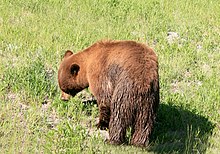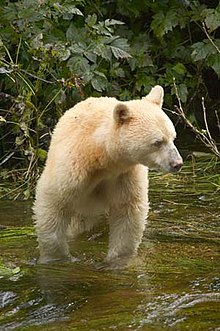If you see a bear remain watchful. Do not approach it. If your presence causes the bear to change its behavior (stops feeding, changes its travel direction, watches you, etc.)—you’re too close. Being too close may promote aggressive behavior from the bear such as running toward you, making loud noises, or swatting the ground. The bear is demanding more space. Don’t run, but slowly back away, watching the bear. Try to increase the distance between you and the bear. The bear will probably do the same.
If a bear persistently follows or approaches you, without vocalizing, or paw swatting, try changing your direction. If the bear continues to follow you, stand your ground. If the bear gets closer, talk loudly or shout at it. Act aggressively and try to intimidate the bear. Act together as a group if you have companions. Make yourselves look as large as possible (for example, move to higher ground). Throw non-food objects such as rocks at the bear. Use a deterrent such as a stout stick. Don’t run and don't turn away from the bear. Don't leave food for the bear; this encourages further problems.
Most injuries from black bear attacks are minor and result from a bear attempting to get at people's food. If the bear's behavior indicates that it is after your food and you're physically attacked, separate yourself from the food and slowly back away.
If the bear shows no interest in your food and you're physically attacked, fight back aggressively with any available object--the bear may consider you as prey! Help protect others, report all bear incidents to a park ranger immediately. Above all, keep your distance from bears!
More information about Black Bears provided by Wikipedia
Although they all live in North America, American black bears are not closely related to brown bears and polar bears; genetic studies reveal that they split from a common ancestor 5.05 mya.[10] Both American and Asiatic black bears are considered sister taxa, and are more closely related to each other than other species of bear.[10][11]
A small primitive bear called Ursus abstrusus is the oldest known North American fossil member of the genus Ursus, dated to 4.95 mya.[12] This suggests that U. abstrusus may be the direct ancestor of the American black bear, which evolved in North America.[10][13] Although Wolverton and Lyman still consider U. vitabilis an "apparent precursor to modern black bears",[14] it has also placed within U. americanus.[13]
The ancestors of American black bears and Asiatic black bears diverged from sun bears 4.58 mya. The American black bear then split from the Asian black bear 4.08 mya.[10][15] The earliest American black bear fossils, which were located in Port Kennedy, Pennsylvania, greatly resemble the Asiatic species,[16] though later specimens grew to sizes comparable to grizzlies.[17] From the Holocene to present, American black bears seem to have shrunk in size,[10] but this has been disputed because of problems with aging these fossil specimens.[18]
The American black bear lived during the same period as short-faced bears (Arctodus simus and A. pristinus) and the Florida spectacled bear (Tremarctos floridanus). These Tremarctine bears evolved from bears that had emigrated from Asia to North America 7–8 ma.[19] The short-faced bears are thought to have been heavily carnivorous and the FL spectacled bear more herbivorous,[20] while the American black bears remained arboreal omnivores, like their Asian ancestors. The black bear's generalist behavior allowed it to exploit a wider variety of foods and has been given as a reason why of these 3 genera, it alone survived climate and vegetative changes through and last ice age while the other more specialized North American predators went extinct. However, both Arctodus and Tremarctos had survived several other ice ages. After these prehistoric Ursids went extinct during the last glacial period 10,000 years ago, black bears were probably the only bear present in much of North America until the arrival of Brown Bears to the rest of the continent.
Build

Some specimens may develop a white “crescent moon” mark on the chest. This white mark, which is constant in Asiatic black bears, occurs in only 25% of American black bears[30]
[edit] Size
Black bear weight tends to vary according to age, sex, health and season. Seasonal variation in weight is very pronounced: in autumn, their pre-den weight tends to be 30% higher than in spring, when black bears emerge from their dens. Black bears on the East Coast tend to be heavier on average than those on the West Coast. Adult males typically weigh between 125 and 550 lb, while females weigh 33% less at 90–275 lb.[34] The largest subspecies on average is U. americanus carlottae of the Queen Charlotte Islands and Alaska.[35] The biggest wild American Black Bear ever recorded was a male from North Carolina, shot in 1998, that weighed 400 kg (880 lb).[34] Adults are 4–6 ft in length, and 2.5–3 ft in shoulder height.[31] The North American Bear Center, located in Ely, Minnesota, is home to the world's largest captive male and female black bears. Ted, the male, weighed 950–1,000 lb (430–450 kg) in the fall of 2006.[36] Honey, the female, weighed 555.5 lb (252.0 kg) in the fall of 2007.[37]
[edit] Pelage
The fur is soft, with dense underfur and long, coarse, thick guard hairs.[31] The fur is not as shaggy or coarse as that of brown bears.[38] American black bear skins can be distinguished from those of Asiatic black bears by the lack of a white mark on the chin and hairier footpads.[39] Despite their name, black bears show a great deal of color variation. Individual coat colors can range from blond, cinnamon, or light brown to dark chocolate brown or to jet black, with many intermediate variations existing. Bluish tinged black bears occur along a portion of coastal Alaska and British Columbia. White to cream colored black bears occur in coastal islands and the adjacent mainland of south-western British Columbia. Albino specimens have also been recorded.[40] Black coats tend to predominate in moist areas such as New England, New York, Tennessee, Michigan and western Washington. 70% of all black bears are black, though only 50% of black bears in the Rocky Mountains are black.[31]
Black bears are not true hibernators, but they do become significantly less active and go into a dormant state during the winter months. This is sometimes referred to as "seasonal lethargy." Black bears enter their dens in October and November. Prior to that time, they can put on up to 30 pounds of body fat to get them through the seven months during which they fast. Winter dormancy in Black Bears typically lasts 3–5 months.[22] During this time, their heart rate drops from 40–50 beats per minute to 8 beats per minute. They spend their time in hollowed-out dens in tree cavities, under logs or rocks, in banks, caves, or culverts, and in shallow depressions. Females, however, have been shown to be pickier in their choice of dens, in comparison to males.[42] A special hormone, leptin is released into their systems, to suppress appetite. Because they do not urinate or defecate during dormancy, the nitrogen waste from the bear's body is biochemically recycled back into their proteins. This also serves the purpose of preventing muscle loss, as the process uses the waste products to build muscle during the long periods of inactivity. In comparison to true hibernators, their body temperature does not drop significantly (staying around 35 degrees Celsius) and they remain somewhat alert and active. If the winter is mild enough, they may wake up and forage for food. Females also give birth in February and nurture their cubs until the snow melts.[43] During winter, black bears consume 25–40% of their body weight.[44] The footpads peel off while they sleep, making room for new tissue. After emerging from their winter dens in spring, they wander their territories for two weeks so that their metabolism accustoms itself to the activity. They will seek carrion from winter-killed animals and new shoots of many plant species, especially wetland plants.[44] In mountainous areas, they seek southerly slopes at lower elevations for forage and move to northerly and easterly slopes at higher elevations as summer progresses. Black bears use dense cover for hiding and thermal protection, as well as for bedding.
[edit] Dietary habits

Illustration of a cow elk being killed by a black bear, from The Natural History of Quadrupeds by Frederick Shoberl, 1834
Up to 85% of the black bear's diet consists of vegetation,[32] though they tend to dig less than brown bears, eating far fewer roots, bulbs, corms and tubers than the latter species.[40] Young shoots from trees and bushes during the spring period are important to black bears emerging from hibernation, as they assist in rebuilding muscle and strengthening the skeleton and are often the only digestible foods available at that time. During this period, they may also raid the nut caches of squirrels.[44] Black bears are fond of honey, and will gnaw through trees if hives are too deeply set into the trunks for them to reach them with their paws. Once the hive is breached, black bears will scrape the honeycombs together with their paws and eat them, regardless of stings.[38]
The majority of the black bear's animal diet consists of insects such as bees, yellow-jackets, ants and their larvae.[44] Black bears will fish for salmon during the night, as their black fur is easily spotted by salmon in the daytime. However, the white furred black bears of the islands of western Canada have a 30% greater success rate in catching salmon than their black furred counterparts.[45] They will prey on mule and white-tailed deer fawns in certain areas.[46][47][48] In addition they have been recorded preying on elk calves in Idaho[49] and moose calves in Alaska.[50] Black bears rarely attack adult deer, which are too swift, but have been recorded killing adult deer confined in wooden traps.[51] They may hunt adult moose by ambushing them as they pass by.[52] Black bears often drag their prey to cover, preferring to feed in seclusion and frequently begin feeding on the udder of lactating females, but generally prefer meat from the viscera. The skin of large prey is stripped back and turned inside out with the skeleton usually left largely intact. Unlike wolves and coyotes, black bears rarely scatter the remains of their kills. Vegetation around the carcass is usually matted down by black bears and their droppings are frequently found nearby. Black bears may attempt to cover remains of larger carcasses, though they do not do so with the same frequency as cougars and grizzly bears.[53] They may climb up to bald eagle nests to eat the eggs or chicks.[32] Black bears have been reported stealing deer and other animals from human hunters.






No comments:
Post a Comment